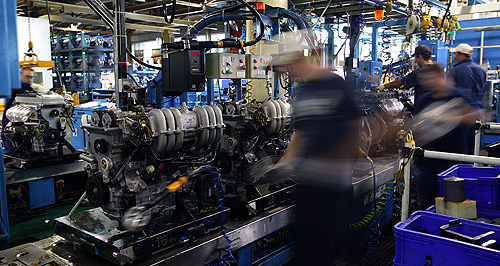Make / Model Search
News - General News - GovernmentVictorian government transition plan welcomedNew beginnings: The Australian Automotive Aftermarket Association and the Victorian Automobile Chamber of Commerce have said they support the Victorian government's transition plan. Parts industry to receive $46.5 million transition aid from Victorian government8 Dec 2015 By IAN PORTER THE automotive parts sector has welcomed the addition of a $46.5 million Victorian government plan to the arrangements already in place to aid in the transition away from automotive manufacturing in the next few years. The plan will help soften the blow for workers and the state economy, when around 35,000 directly employed automotive workers lose their jobs when the three car manufacturers – Ford, Holden and Toyota – shut their plants by the end of 2017. Victorian premier Daniel Andrews said the Automotive Transition Plan had been designed to help parts-makers diversify and workers retrain as well as attracting investment into communities that would be affected by the closure of the car assembly operations. It is believed the Automotive Transition Scheme is separate to the two funds established when the Ford closure was announced – the Geelong Region Innovation and Investment Fund (GRIIF) and the Melbourne’s North Innovation and Investment Fund (MNIIF). The new plan will help preserve some of Australia’s design, engineering and manufacturing skills, according to Australian Automotive Aftermarket Association (AAAA) chief executive Stuart Charity. “Automotive manufacturing is at the pointy end (of manufacturing). It is a complex and high-technology sector,” Mr Charity said. “It would be tragic to lose Victoria’s high technology automotive manufacturing capability. The Automotive Transition Plan will help keep skilled jobs and precision production processes alive in this state.” The AAAA represents more than 250 parts manufacturers across Australia. The Automotive Transition Plan includes a $33 million budget for the creation of new jobs in the areas where plants will close, an $8.4 million program in Melbourne’s south-east to strengthen skills, training and job search support and $5 million to fund a Supply Chain Transition Program to help companies find new markets. In addition, there will be an incentive program for employers to hire displaced automotive workers. They will receive $7000 when they hire such a worker and a further $4000 if they provide the worker with accredited training. Victorian Automobile Chamber of Commerce (VACC) executive director Geoff Gwilym said he was pleased that the plan covered several areas of the industry, particularly the smaller companies that might find it difficult to diversify. “Many of these businesses have some tough times ahead once the car factories close down, but may others are looking at these closures as an opportunity, and we’re glad to see the Victorian government supports that,” he said. “With assistance to keep businesses operating where viable, the outcome for the community is far greater than seeing a business close and jobs lost,” said Mr Gwilym, who also speaks on behalf of the Federation of Automotive Products Manufacturers (FAPM), and whose activities are being wound down. Mr Charity said it was important to keep as much sophisticated equipment and as many skilled workers employed in local plants as possible. “Our automotive technologies are applicable to military vehicles, buses and trucks, rail and tram, agriculture and construction equipment, aircraft and other sectors, such as medical and scientific equipment. “There are a number of Australian original equipment component manufacturers successfully exporting to car makers overseas. We believe many more local companies can follow this example,” Mr Charity said. The new plan has emerged only weeks after the launch of the Australian Automotive Products Manufacturers and Exporters Council (APMEC), which was formed by the AAAA to help influence governments to introduce policies that encourage innovation, commercialisation of new products and growth in the auto sector that will remain after 2017. “APMEC will also help our automotive manufacturers to diversify the products they make and the markets they reach. “Australia’s automotive industry has skilled workers, good infrastructure and financial systems, and sophisticated design, engineering and production technologies. “These attributes have enabled our manufacturers to establish an international reputation as suppliers of high quality products,” Mr Charity said. “We must continue to capitalise on these advantages. The Victorian government program will be a great asset in achieving this aim.” The GRIIF and MNIIF schemes were established in Victoria in the wake of the announcement that Ford would be closing in Victoria. The schemes were designed to help companies in the affected regions develop new products and hire some of the displaced automotive workers. Funding for these two schemes comprised $30 million from the federal government, $9 million from the state government and $9 million from Ford Australia. The money has been split evenly between the two funds.  Read more1st of December 2015  New voice for local parts-makersNew council to promote parts manufacture, research, innovation and exports10th of September 2015  New industry council to help auto parts-makersAAAA launches Automotive Products Manufacturers and Exporters Council22nd of August 2015  Car industry funds could push out to 2021Inquiry recommends making assistance funds available to wider range of companies7th of August 2015  Abbott turns to Geelong with $14m centreGovernment puts $14m into manufacturing ‘growth’ centre but budget cuts still hurt14th of April 2015  Lack of vision for parts sector ‘scary’: AAAAPeak aftermarket body slams federal government for ignoring parts sector10th of March 2015  Government backs down on ATS cuts$500 million cut to automotive industry support scheme ditched by coalition |
Click to shareGeneral News articlesResearch General News Motor industry news |











Facebook Twitter Instagram